Back to Dyeing Silk
I've been dyeing Bombyx silk top, to fill in a few color gaps in the packets for SOAR. The process is easy, thanks to Turkey Roaster Extraordinaire, a 1956 Westinghouse model, once in regular use at our summer cabin, but having since been *liberated*:
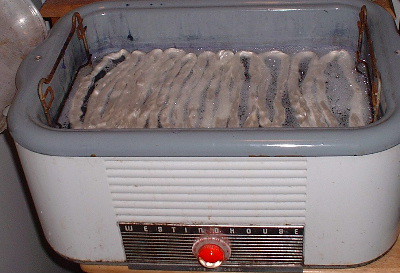
The first step in the process is de-gumming. The sericin needs to be removed so the dye will penetrate. I use a soda ash bath, with a bit of detergent (the exact recipe is *about* 2T soda ash and a *squirt* of Dawn dish detergent in the roaster, fill to about 3" depth with water). Then lay the silk top on the water:
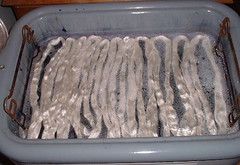
Turn the roaster to 250ºF:

put the lid on and walk away for three hours.
When I come back, the silk looks like this:
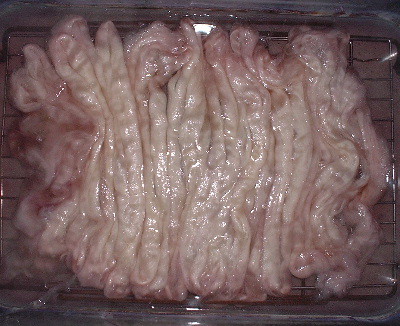
fully hydrated, and theoretically relieved of sericin. The silk is pulled out using the very rusty old racks (yes!) and left to drain a bit, no rinsing, while I prepare the dyebath (several t. of citric acid and a cup or so of dyes, color or colors of choice, in this case violet). The silk gets re-entered, the roaster is still set at 250º:
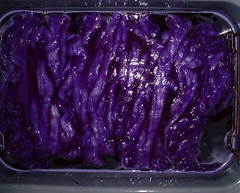
At the end of three hours, the silk has taken up much of the dye. The roaster has an element that runs around the sides, not the bottom or the top of the unit, so *most* of the dye is taken up where the heat strikes first, at the edges:
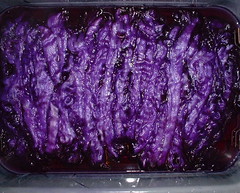
There is dye left in the pot, so the silk remains while the pot cools, taking up the remaining dye:
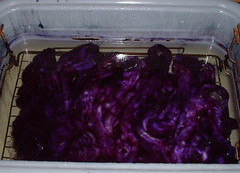
At this point, it gets a rinse, I spin out the excess water, and drape it over something to dry.
Color after color piles up, and then I ultimately divide them all into packets for the class. I started the dividing yesterday, and realized I needed more brights. So next, I'll be dyeing orange, yellow and gold (yay, my favorites!).

The first step in the process is de-gumming. The sericin needs to be removed so the dye will penetrate. I use a soda ash bath, with a bit of detergent (the exact recipe is *about* 2T soda ash and a *squirt* of Dawn dish detergent in the roaster, fill to about 3" depth with water). Then lay the silk top on the water:

Turn the roaster to 250ºF:

put the lid on and walk away for three hours.
When I come back, the silk looks like this:

fully hydrated, and theoretically relieved of sericin. The silk is pulled out using the very rusty old racks (yes!) and left to drain a bit, no rinsing, while I prepare the dyebath (several t. of citric acid and a cup or so of dyes, color or colors of choice, in this case violet). The silk gets re-entered, the roaster is still set at 250º:

At the end of three hours, the silk has taken up much of the dye. The roaster has an element that runs around the sides, not the bottom or the top of the unit, so *most* of the dye is taken up where the heat strikes first, at the edges:

There is dye left in the pot, so the silk remains while the pot cools, taking up the remaining dye:

At this point, it gets a rinse, I spin out the excess water, and drape it over something to dry.
Color after color piles up, and then I ultimately divide them all into packets for the class. I started the dividing yesterday, and realized I needed more brights. So next, I'll be dyeing orange, yellow and gold (yay, my favorites!).

5 Comments:
What a brilliant gadget! Even more useful than a slow cooker, because of the racks.
Nice purple, too.
That looks luscious enough to eat.
YOU didn't dye enough brights?
My roaster has such sentimental value that I bought a new one to use for dyeing.
damn, my roaster died. i'm depressed. the purple looks totally regal.
Do you change the water between the first soak to release the sericin and adding the dye?
Post a Comment
<< Home